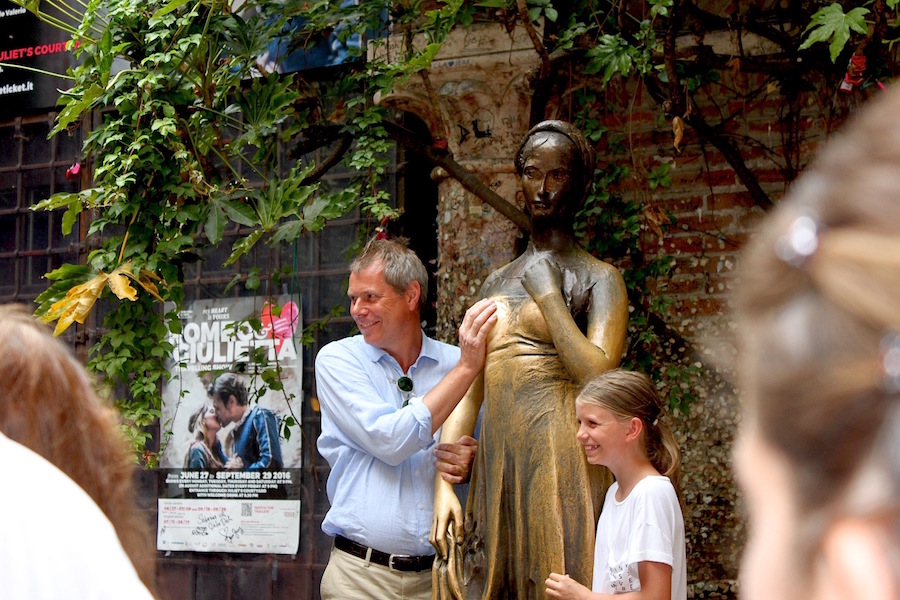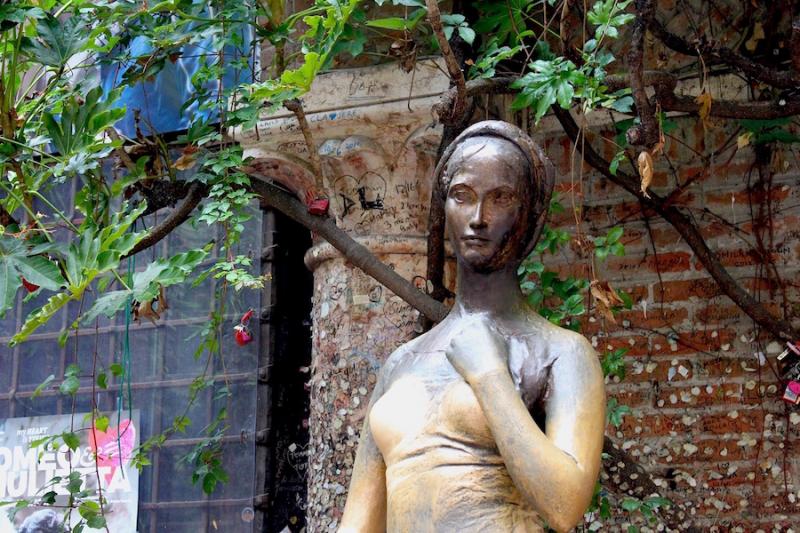In many areas of Italy, tradition is as important as superstition and Italians are deeply devoted to their local rituals and habits. Some of these are linked to a place's history, others to a specific event, a religious belief or evocative fables.
Yet, no matter how weird they may seem, many people still believe they can bring good luck or help them achieving a specific goal, be it a love affair, a job, school problems or something related to health.
And, let's admit it, if you really want something you'd do anything to get it, even laying down on the ground of an ancient “Giants' tomb” in Sardinia.
If you want to do as Romans do, and you do think that a bit of luck wouldn't hurt, we collected some of Italy's weirdest rituals and superstitions according to the purpose or issue they are related to.
Good luck
In Florence, touching the nose of the “little pig” fountain – which is a boar, actually – in the Loggia del Mercato Nuovo (New Market) is said to bring good luck. This probably originated from the general symbolic meaning of water and abundance, and this is why the boar's nose is always shining. Yet, in recent years the legend evolved and today those looking for good luck or making a wish also have to put a coin into the animal's mouth: if, sliding down, the coin goes into the fountain's grill, the wish will come true.

In Turin, the symbol of the city is a rampant bronze bull which is also engraved on the stone floor of the beautiful Piazza San Carlo, dating back to 1930. According to a local legend, treading upon its testicles would bring good luck. Turin's inhabitants deeply believe in this superstition yet, being quite reserved people, they often try to do it while unnoticed. If you want to catch them doing it, seat at one of the outside tables of Caffè Torino and attentively observe the scene in question.
A similar habit is seen in Milan: stepping on the mosaic of a bull on the floor of the elegant Galleria Vittorio Emanuele, pointing the heel upon its testicles and rotating three times on them with one's eyes closed, is supposed to bring good luck. Apparently, this is true only if performed at midnight of the 31st December, yet many people do it every day and the mosaic's condition, often in need of repair, testifies it.
In Rome, one can touch the nose of the bronze she-wolf statue inside the Senate Palace; sadly, the palace, hosting Roma Capitale’s board offices, is normally closed to the public.
In Naples, an old habit is stroking the skulls (cap’e mort’, literally the “heads of the dead”) kept in the underground space of the baroque church of Santa Maria delle Anime del Purgatorio ad Arco, devoted to the cult of Purgatory. People used to “adopt” a skull belonging to a buried corpse and would take good care of it, cleaning it and creating a small altar for prayers in order to make the passage from Purgatory to Heaven easier. The relieved soul would thus protect the pious person from above.
Other superstitions in Naples recommend not to put hats on the bed, and the latter should never point towards a door.
Merry romances and unfaithful lovers
In Verona, in the courtyard of the “so-called Juliet's house” there is a copy of the bronze statue of Juliet by sculptor Nereo Costantini, displayed inside the house. It was damaged by too many love-seekers, since the legend goes that touching Juliet's bosom helps finding true love. Now people have to make do with the copy and see if that works, too.

In Rome, the smaller fountain on the right side of the more famous Trevi Fountain – called the Lovers' fountain – has a romantic side to it as the name suggests. According to the legend, couples drinking its water will stay faithful and in love forever. There used to be even a specific ritual for lovers parting (such as lads going off to the army). The night before the farewell, they met at the fountain and the girl filled a brand-new glass with water and offer it to guy, then they had to break it. Thus, she could be sure that he'd have returned to her. This is probably linked to the belief that the beauty of the Trevi fountain itself make people want to come back to Rome.
In Naples, someone says it's better not to bring your sweetheart at San Martino, the beautiful Charterhouse – today a museum – is perched on the top of the Vomero Hill. Saint Martin is considered the betrayed husbands' protector, probably because on his name day –11 November – cattle's fairs, full of horned animals, were usually held. Consider if you really want to believe this old fable, since the Charterhouse's gardens are very romantic and the view from here is unique.
In Bari, the Cathedral of Saint Nicholas is linked to many legends and miracles. In particular, one of the red marble columns of the underground crypt – now kept in an iron gate at the entrance of the crypt – is believed to have miraculous properties. Touching it would heal from diseases, yet also single women – locally called vacandine – use to visit the church walking around the column three times on the Saint's day – 6 December – to ask his help in finding a good husband or getting pregnant. The column would have been taken here by the saint from Rome, where he found it during the demolition of the house belonging to a woman of ill-repute.
Successful studies
Apparently, students in Pisa are quite superstitious and there is a wide scope of traditions linked to high school or university studies in the city.
For example, there are many things one should not do in order to pass an exam or get the degree, like climbing up to the top of the famous leaning tower or making a complete tour around it.

Stroking the bronze double-tailed lizard sculpted on the door of the close-by baptistery exactly 100 days earlier than the final exam to get the high school diploma, would help passing it.
Someone also says that it is good luck – even for passing the above-mentioned exam – if one can count twice in the same number the so called “Devil's claws” (an indefinite number of small holes on the marble wall) on the side of the Dome near the tower. Allegedly, as a Devil's prank, their number always changes. Try it yourself if you can!
In Bologna, if one wishes to finish his studies and get a degree, he or she should never cross in diagonal the beautiful Piazza Maggiore, the city's main square.
For the same reason, in Padova one should never jump over the chain at the entrance of Palazzo Bo, one of the university buildings.
In Siena – another famous university town – it is “forbidden” to climb up to the top of the Torre del Mangia.
In Rome, students at University La Sapienza are very careful not to look into the eyes of the Minerva statue at the entrance of the main building if they want to pass the exam on that day.
In Naples, Medicine and Surgery students avoid visiting the charming and mysterious Cappella San Severo (San Severo Chapel Museum) with its incredible marble statues and the disturbing “Anatomical Machines” - namely the skeletons of a man and of a woman showing the artery and vein systems almost perfectly intact, made in the XVIII century by a doctor under the direction of the Prince Raimondo di Sangro. Seeing these works would prevent them from achieving their degree.
In Perugia, students don't walk along the rain draining canals in corso Vannucci and don't go to historic Sandri Bakery on the same road, giving up to its delicious cakes: now that is a loss!
Health and fertility
The whole Sardinia island is peppered with bewitching “Giants’ tombs”, burial monuments belonging to the Nuragic era (Bronze Age or even earlier). Allegedly, besides the symbolic and ritual meaning, those huge stone monuments would also be “telluric energy accumulators”, with special healing properties. You can experiment it by yourself lying on the ground of the imposing S'Ena e Thomes Giant Tomb in Dorgali, or in another one of the many existing tombs (check the nurnet.it website for a complete map).

An old habit in Naples is linked to a painting representing St. Raphael (whose name means “God has healed” in Jewish language) saving a man called Tobia from a giant fish, displayed in the St. Raphael’s church in the Materdei borough. Following the old saying “va’ a vasà ‘o pesce ‘e San Rafèle“ (go kiss Saint Raphael’s fish), not without a blasphemous sexual innuendo, barren women go ask the Saint to help them reach their aim of falling pregnant.
With a similar purpose, many Neapolitan – and foreign – women still nowadays come sit on the “fertility chair” (or holy chair) in the St. Maria Francesca church, devoted to the Saint who lived in Naples in the '700. The chair is where the suffering Saint, who also developed stigmata, used to rest.
Historical habits
In almost every Italian town and village there are plenty of habits often connected to local history.
For example, in Modena people still perform – or pretend to – public speeches standing on the ancient “preda ringadora” (the “addressing stone”, a huge marble stone dating back to the X century) in the beautiful Piazza Duomo. The stone, though, actually has a grim story behind it: here the condemned were exposed to public shaming or executed, and the corpses were then exhibited.
In Matelica, a charming little town in Marche region, turning 7 times around the beautiful fountain in piazza Mattei – of course, with official witnesses! – will give you the right to earn the “mad licence” (patente de mattu). The habit dates back to the VI century and apparently has something to do with the locals’ weird attitude.

In Gubbio, the lovely medieval town in Umbria, there is a similar belief linked to the Bargello fountain, but it only takes three rounds.
In Rome, the already mentioned Trevi Fountain also has its own legend: throw a coin into the fountain, you’ll visit Rome again soon. The Eternal City also boasts an ancient “lie detector”: the famous Bocca della Verità (the Mouth of Truth) a round marble stone representing a man-like face (probably a pagan god, maybe Oceanus or the river Tiber) located in the portico of the church of Santa Maria in Cosmedin.

Dating back to Ancient Rome and probably part of a fountain, since the Middle Ages the sculpture was believed to be able to detect lies, biting the hand of a liar, if put inside its mouth. Today, a 2-euro payment is necessary to visit the portico and take a picture of the sculpture.









